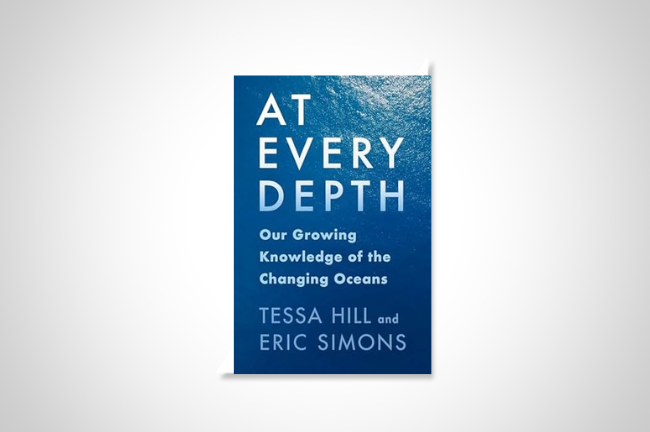You have /5 articles left.
Sign up for a free account or log in.

Columbia University Press
The earth’s atmosphere does not recognize national borders, and neither does the ocean, which makes up 71 percent of the planet’s surface. By habit we refer to oceans, plural, but that, again, is a matter of boundaries imagined where none really exist. Between the sea and the sky, it seems, the world exhibits quite an indifference to human efforts to divvy it up.
For our part, humans have often regarded the ocean and the atmosphere as inexhaustible resources: too vast to fathom, too big to fail. This turns out to have been a catastrophic mistake, as evidenced by melting permafrost and floating archipelagos of plastic garbage.
Tessa Hill and Eric Simons’s At Every Depth: Our Growing Knowledge of the Changing Oceans (Columbia University Press) is an antidote to indifference, a call to deepened attention. Much of the book is necessarily given over to describing and explaining ecological developments that range from the worrisome to the horrific. (Example: “In albatross breeding colonies across the Pacific, the large ocean-roaming birds die with stomachs full of plastic, their bodies decomposing until all that remains is a neatly arranged pile of human junk.”) But the authors mean to be as encouraging as possible within the limits of intellectual responsibility.
Hill is a professor of earth and planetary sciences at the University of California, Davis, while Simons is a science writer and the former editor of Bay Nature magazine. At Every Depth combines popular-science sketches of the history and findings of oceanography with reflections on a change of ethos within the discipline over roughly the past quarter century. The chapters move into literally ever-deeper waters: from tidal pools (the shallow but distinctive ecosystems forming among rocks on the shoreline) outward to coral reefs and beyond, and finally to the trenches running across the seafloor, where no sunlight reaches. The deep sea contains “over 90 percent of the total volume of the world’s oceans,” the authors write, “a reservoir so vast that it may seem impossible to change it.”
A presumption of changeless stability has been a given, they write, since at least the late 19th century, when researchers began collecting “the kind of world-spanning measurements [of ocean temperature] that emphasize stability and gloss over variability.” A more dynamic picture emerged with the close study of distinct ecosystems that have taken shape in every zone—even the “near-freezing black darkness of the deep,” which is likely home to many more species than have been discovered so far.
From interviews with oceanographers and narrative presentation of their findings, the authors convey something of the passionate attention that goes into the detailed understanding of a given aquatic ecosystem.
But this pursuit took on a tragic aspect late in the 20th century as researchers confronted coral reef “bleaching” on a growing scale. The reefs—“equivalent to rainforests on land in terms of their biodiversity and ecological and physical complexity”—embodied a symbiotic relationship between corals and the colorful algae growing on them. Under the stress of extreme heat, the coral will expel the algae—to the detriment of both organisms.
Before the late 1970s, bleaching was an infrequent, isolated, and sometimes reversible phenomenon. But increasing sea-surface temperatures and water acidification (each the effect of increasing carbon dioxide emissions) have driven a series of “global bleaching events” hitting coral reefs since 1997.
At Every Depth quotes one scientist’s recollection of the impact: “Some place you’ve called home for so long, spent hours diving that site for so long, it was like diving on the moon, that was how foreign it was.” Gatherings of coral-reef specialists sound grim. Rehabilitation efforts are underway, but reversing the process on anything like its disastrous scale is simply not in the cards.
And it is only one such instance: Hill and Simons find no region of the ocean untouched by human ecological impact. “A study of amphipods collected in the Mariana Trench, the deepest spot on Earth,” they write, “showed the tiny animals were laden with human-produced polychlorinated biphenyls, chemicals banned for decades. The same study found that every one of the amphipods collected had ingested plastic.”
What keeps the book from sounding like a muffled cry of despair? For one thing, the authors return from time to time to reminders that humankind’s relationship with the ocean predates recorded history.
Archeological evidence shows that Homo erectus was eating shellfish 800,000 years ago; fishhooks were in wide use 23,000 years ago; and the body in a burial site dated to 10,000 BCE was interred with fishhooks and “a perforated cockleshell, showing evidence of polish and still bearing traces of a red colorant." Whether left as tokens of respect or to allow the deceased to fish in the afterlife, these items are undeniably emblematic of a culture with aquatic roots. Likewise with the peoples of the South Pacific islands, able to navigate formidable distances in vessels far more modest than Atlantic mariners used.
And the ability to harvest an ecosystem without destroying it in the process was passed down for generations in the Pacific Northwest, where Indigenous peoples sustained high levels of protein consumption through clam farming and other aquacultural practices. Their expertise was long disregarded, and their communities dispersed. But recent cooperative efforts between Indigenous knowledge-holders and oceanographers give the authors some hope for other new forms of collaboration.
“The ocean has changed so fast in the last few years,” write Hall and Simons, “faster than at any point in the entirety of human life on Earth, that our ability to observe struggles to keep pace.” But resigning oneself to gathering knowledge of dying ecosystems is no way to live. “The problems we face today,” the authors continue, “do not in fact represent a static condition of the ocean but rather (we hope) a turning point.”
In what direction? One facing “a new kind of future for the ocean. One that builds on the best available knowledge to encourage resilience, and cares for the communities of people whose future is deeply entwined with the survival of every species on this planet.” The book itself is not a map to that destination but an encouragement to keep looking.








